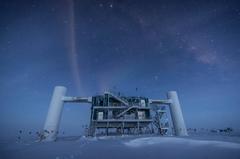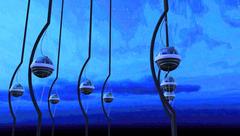URL: https://www.desy.de/news/news_search/index_eng.html
Breadcrumb Navigation
DESY News: Latest result from neutrino observatory IceCube opens up new possibilities for particle physics
News
News from the DESY research centre
Latest result from neutrino observatory IceCube opens up new possibilities for particle physics
The South Pole observatory IceCube has recorded evidence that elusive elementary particles called neutrinos changing their identity as they travel through the Earth and its atmosphere. The observation of these neutrino oscillations, first announced in 1998 by the Super Kamiokande experiment in Japan, opens up new possibilities for particle physics with the Antarctic telescope that was originally designed to detect neutrinos from faraway sources in the cosmos.“We are very pleased that the IceCube detector with its DeepCore array can be used to observe neutrino oscillations with high precision,” says Olga Botner, Spokesperson of the IceCube experiment. “DeepCore was designed on the initiative of Per Olof Hulth who sadly passed away recently, to significantly lower IceCube's energy threshold. The results show that IceCube can contribute to nailing down the oscillation parameters and motivate us to pursue our plans for an IceCube upgrade called PINGU to measure neutrino properties.”

The IceCube laboratory at the Scott Amundsen South Pole station hosts the computers collecting the detector data (picture: Felipe Pedreros. IceCube/NSF)
Neutrinos remain the most mysterious of the known elementary particles. Postulated by Austrian physicist Wolfgang Pauli in 1930, it took 25 years for their experimental detection. “Neutrinos are elusive," says Olga Botner, " and can travel through an enormous amount of material, even the whole Earth, without interacting." Nevertheless, physicists have built more and more sophisticated instruments to reveal the mysteries of this very light particles. One of the surprising results was that the three different types of neutrinos, electron, muon and tau neutrinos, can change their identity, transforming from one type of neutrino to another. This phenomenon is known as neutrino oscillation. “Neutrino oscillations are only possible if neutrinos have a mass,” explains Nahnhauer. “On the other hand, massive neutrinos are not explained within the otherwise so successful Standard Model of particle physics.” The strength of the oscillation and the distances over which it develops depend on two parameters: the so-called mixing angle and the mass difference. The values of these parameters have been constrained by precise measurements of neutrinos from the sun, the atmosphere, nuclear reactors, and particle accelerators.

Artistic rendering of IceCube DOMs (digital optical modules) in the Antarctic ice (picture: Jamie Yang, IceCube Collaboration)..
Now IceCube has proven that it can also deliver top particle physics results. The new measurement by the IceCube collaboration resulting in significantly improved constraints on the neutrino oscillation parameters has been accepted for publication by the scientific journal Physical Review D.
Three years of IceCube data yielded a similar precision to that reached from about 15 years of Super-Kamiokande data. In contrast to the purified water in Super-Kamiokande’s 50-kiloton vessel, IceCube uses a natural target material, the glacier ice at the South Pole. IceCube’s 500 times larger observation volume produces larger event statistics in shorter times. “Both Super-Kamiokande and IceCube use the same ‘beam‘ which is atmospheric neutrinos, but at different energies. And we reach similar precision of the measurable oscillation parameters,” says Juan Pablo Yanez, postdoctoral researcher at DESY, who is the corresponding author of the paper. “The results now derived from IceCube data show errors still larger than, but already comparable to the most precise neutrino beam experiments MINOS and T2K. But as IceCube keeps taking data and improving the analyses we are hopeful to catch up soon.” adds Yanez.
Currently the scientists are planning an upgrade of the IceCube detector called PINGU (Precision IceCube Next Generation Upgrade). A much higher density of optical modules in the whole central region will improve the sensitivity to several fundamental questions associated with neutrinos.
“In particular we want to measure the so called neutrino mass hierarchy – whether there are two heavier neutrinos and one light one, or whether it is the other way around.” explains Rolf Nahnhauer. “This is important to understand how neutrinos obtain masses, but also has significant relevance on how the cosmos evolves. The current results provide an important experimental confirmation that our concepts work.“



